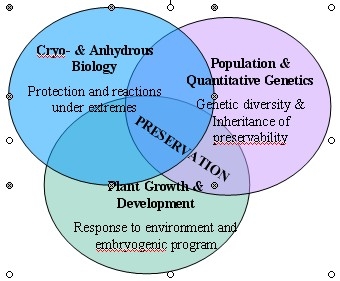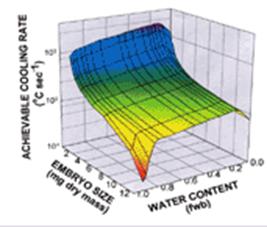| Research to Develop Strategies and Technologies for Preserving Genetic Diversity in ex situ Genebanks (PGPR) (1) |

|
Research to Develop Strategies and Technologies for Preserving Genetic Diversity in ex situ Genebanks (PGPR)
 Principal Investigators
Principal Investigators
Christina Walters (Lead) Christina.Walters@ars.usda.gov
Gayle Volk
Gayle.Volk@ars.usda.gov
Chris Richards
Chris.Richards@ars.usda.gov
Project Summary
The PGPR team conducts research to improve the biological and genetic integrity of genebanked germplasm and to standardize procedures for handling accessions and reporting associated data. (Genebanking Strategies) Interrelated research goals will allow curators to preserve viability of conservation targets (Objective 1) and rationalize and validate the genetic diversity and integrity of those targets (Objective 2). Using taxa that are empirically-tractable systems, we will
- define tolerances to preservation stresses,
- develop methods to improve survival or reliably predict loss of viability over time,
- model the effects of mortality and regeneration on genetic composition,
- develop sampling strategies for wild-collected germplasm that maximize genetic diversity while minimizing curator inputs for storage and regeneration.
A central theme is identifying appropriate conservation targets that capture desired genetic diversity, remain viable during storage and are available to the user when needed. A conservation target is a group of propagules (such as seeds or pollens) or an individual propagule (such as an explant) that comprises an accession valued for specific genes, genetic richness (number and frequency of alleles) or an allelic combination (genotype).
| PGPRU scientists and their collaborators will investigate major conceptual issues of repository biology and standardization using within-unit expertise in biophysics, plant physiology, cell and molecular biology and population genetics and NPGS curators' expertise on reproductive biology, phenotypic diversity, history and cultivation of their assigned collections. Our central position within NPGS allows us to develop protocols and predictive tools that are applicable to a wide variety of species and propagules. |  |
| Project Objectives
Objective 1: Develop tools to assess changes in plant germplasm viability and evaluate causes for lost viability during preservation. Long-range research goals are to develop generalized schemes that maintain viability of diverse propagules in genebanks. Research will identify sensitivity to and damage caused by preservation stresses, recovery pathways after preservation, and handling procedures before storage that affect survival. Because genebanking is labor intensive and fraught with risks of genetic erosion, methods to identify and ameliorate bottlenecks are needed (Objective 2). |
 |
 |
|
Objective 2: Develop statistical genetic strategies and tools to sample and preserve plant genetic diversity in genebank collections and in situ reserves. Knowledge from Objective 1 about propagule preservation and genetic factors that influence quality and recovery provides the context for this objective. Linked projects will identify the extent and mechanisms of genetic change within existing collections and model genetic variation from different sampling and regeneration schemes. We will develop analytical tools that quantify genetic structure to guide decisions on what to collect, when to regenerate and how much is needed to assure genetic identity of the sample through time. This requires developing predictions based on theory, testing these predictions using NPGS accessions, and finally applying the knowledge to guide management decisions.
|
|
Need for Research
Plant genebanks are an important source of research materials supporting studies of crop improvement, new crops, ecology, evolutionary processes, conservation, systematics, plant metabolic processes, gene function and comparative genomics. A high degree of complexity is required to ensure the quality of genebanked samples, especially as researchers' needs change and collections ever increase in size and age. The process of preservation imposes tremendous stress to cells. Capturing a broad range of diversity with differing responses to stress is a major genebanking goal, but the variation itself contributes to the problem of developing broadly applicable preservation protocols. Greater emphasis on wild-collected germplasm and specific genotypes of obligate out-crossing plants creates greater challenges to maintaining genetic richness and viability ex situ. One strategy is to ameliorate losses of germplasm during storage by preventing irreparable damage to propagules (Objective 1). Another strategy is to mitigate genetic erosion by managing collection size, diversity and conservation target (Objective 2).
Mortality during storage and its consequences to maintaining and expanding genetic diversity of small populations are significant impediments to efficient ex situ preservation. The ability to preserve diverse propagules within a species provides options for conserving genetic diversity within a collection and we plan to integrate developed technologies into multidimensional strategies that efficiently back up collections in long term storage. Some propagules are extremely sensitive to preservation stresses and the challenge is to develop effective storage protocols. Even with good storage protocols, viability declines rapidly after a threshold is reached and current viability monitoring procedures do not predict when this threshold will occur. Risks of genetic change through drift and selection increase with mortality, sample depletion and sample regeneration. Better operational standards are needed to flag samples for regeneration. Therefore, an integrated approach to the cyclical genebanking processes of sampling, preserving, regenerating, sampling, etc., is needed to ensure germplasm has high biological integrity and reliable genetic composition.
Potential Benefits
Viability and genetic diversity of species important to US landscapes and to human well being will be safely preserved in a consolidated facility and always available and replenishable. Genetic diversity will be comprehensive for species, but collections will be the appropriate size and contain the desired conservation targets. We will be able to evaluate propagule longevity upon receipt (before storage), eliminating the need to monitor viability and providing guidelines to schedule regenerations. Researchers will have a broad collection of quality-assured materials with good physical integrity and associated phenotypic, genotypic and ecological data.
Anticipated Products of the Research
- Enhanced capacity of genebanks to preserve viability of diverse cell types that can be retrieved from storage and used to regenerate populations
- Strategic expansion of genebank collections based on knowledge of the genetic variation within and between accessions and reliable preservation protocols for propagules of the appropriate conservation target
- Reliable standards and metrics to evaluate change in biological and genetic integrity of genebanked samples
- New statistical genetic approaches to identify gaps and redundancies in genetic diversity of collections in order to set acquisition and maintenance priorities, respectively
-
Cost/benefit analyses of ex situ conservation strategies



